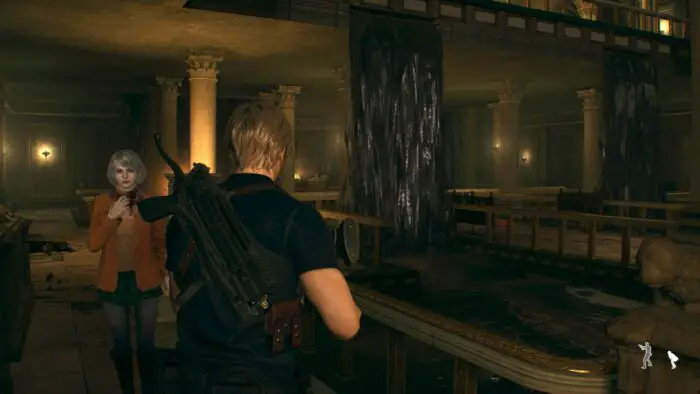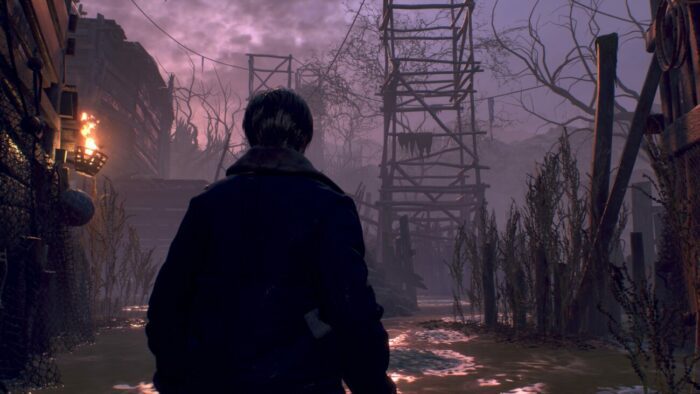To say that Resident Evil 4 is a modern gaming masterpiece is an understatement. The 2005 title is the game that launched a thousand third-person action adventures with its blend of horror and high-octane elements. And that’s not even to mention its complicated place within the Resident Evil franchise, in which its more adrenalized impulses were taken to the extreme in the series’ sixth entry.
Additionally, much like RoboCop (1987), the game’s over-the-top and gonzo nature is a clever satire of an aspect of American culture, namely its exceptionalism in a post-9/11 age, with the main character, Leon S Kennedy being akin to a John Wayne-styled Western gunslinger who has to rescue the president’s daughter. This central aspect, an adaptive difficulty system that makes each playthrough unique, and an intensely fun gameplay loop are some of the reasons why the title has never stopped being my favorite game.
With that in mind, a Resident Evil 4 remake initially sounded like a dicey notion to me (particularly with the release of Resident Evil Village that captured some of Four‘s chaotic verve). However, much to my surprise, the Resident Evil 4 remake is a remarkable refinement of the 2005 classic.
The game depicts Leon S Kennedy (Nick Apostolides) going to a remote Spanish village to rescue the president’s daughter, Ashley Graham (Genevieve Buechner). As Kennedy’s search continues, he finds a larger conspiracy at work when he’s infected with a locally sourced parasite, Las Plagas. With time running out, the former cop and Ashely must fight for survival as the injected parasites threaten to take control of their bodies. To make matters more complicated, a series of past figures start to reappear during Leon’s journey.

As much as I loved the original Resident Evil 4, its shortcomings came mainly from its narrative, which was amusingly erratic at best and underdeveloped at worst. The remake rises to the occasion, making the story more engaging and dramatic. The 15-20 hour experience emerges as an odyssey in which Leon’s qualities as a hardened and veteran agent are tested. Like all good stories that have this structure, the side characters are excellent reflections and ripples of how Leon sees himself.
One character that Leon meets is a former Umbrella scientist called Luis (André Peña). He plays up this bravado about being a Don Quixote-esque figure who thrills in adventuring and womanizing. The characteristics are a front for his guilty conscience because of his past actions with Umbrella. He’s an excellent parallel to Leon, who equally nurses a guilt complex for the lives he could not save in Raccoon City.
By the same token, Leon’s former mentor, Major Jack Krassuer (Mike Kovac), is a dark mirror of what Leon could have been, selling his soul and modifying his body in pursuit of power, so he can no longer feel powerless. In the same vein, during a heated exchange with Ada (Lily Gao), Leon says, “You try to save one person; a hundred others die.” This line is echoed by Albert Wesker (Craig Burnatowski) in a post-credit sequence when he says, “A hundred will give their lives so that one may live. I am expediting that change.” The contrast paints a stark portrait of two men who have different outlooks on the cost of many lives versus one.
In these instances, the writing is wonderfully subtle insofar as Leon is affected by these encounters that leave a mark on him, whether its a new outlook when he says a Luis-esque line about thrill rides to Ashley at the end or picking up his former mentor’s knife, with the knowledge he gained his respect.
This aspect is compounded by a change in Leon and Ashley’s relationship. Aside from being adorable, particularly when they play their games of complimentary tennis like a pair of teenagers at a school disco, there’s respect and empathy in the relationship. Leon relaying what it’s like to be helpless and afraid to a distraught Ashley imbues the player with a newfound respect for her plight. At the same time, the president’s daughter contributes more to the action, whether attempting to save Leon after an early boss fight or asking if he’s okay after tense sequences make her a lot more grounded and human. Genevieve Buechner’s voice performance is also palpable in the fear it illustrates in someone who has been captured for a prolonged amount of time and is initially hesitant to trust her rescuer.
Much like Krassuer and Luis, Ashley is a reflection of an early version of Leon insofar as being a capable and empathetic person who can survive and save people when it counts. It’s as though Leon’s guilty mindset can rest a little easier knowing there are people like Ashley who are not entirely helpless.

In the 2005 original, much of the horror came from mechanical limitations due to a tank control scheme and some of the creatures introduced including the Regenerators and moaning castle monks. The remake plays like a straight-up horror game with many of its sequences having a dread-inducing atmosphere. It’s here where the 3D audio accentuated this feeling with the first hour, in particular, immersing the player in creaks, howls, and alarming sounds. The RE engine also contributes to the horror whether it’s fog-engulfed rooms or violent whistling winds that cause Leon and Ashley to flinch. The famed engine that’s existed since Resident Evil 7 shows no slowdown in its power to graphically impress.
Narratively, the horror is expanded upon too, with many of the notes and letters painting the picture of the sacrifice people make to serve the cult that’s painted in quite overt religious terms. Previous mini-bosses such as Chief Mendez (aka the Big Cheese, voiced by Jon Bryant) and Verdugo have a more scary and tragic dimension within this new religious cult hierarchy. Also, the addition of occasional visions from the central villain, Osmund Saddler (Christopher Jane), results in more tension being wrung out of the plot point of the parasites that infest Leon and Ashley’s bodies.
However, the horror occasionally clashes with the original’s goofy spirit. Many of Leon’s one-liners from the original game are retained here (mostly manifesting during combat sequences). Some of them are discordant with the horror, including the iconic bingo joke undermining the more protracted Church bell sequence.
This is combined with Saddler being flat and uninteresting. In one of the game’s larger changes, Leon’s communications are no longer hacked by the antagonists. So, we lose some of the villains’ colorful natures during these exchanges. This particularly affects Saddler, whose generic vocal performance does not compare with the Dracula-esque charm of the original voice actor (Michael Gough). It also does not help that the new unrobbed design of the character looks like a demented Uncle Fester.

In terms of gameplay, the Resident Evil 4 remake is a lot smoother, with a control scheme that feels as responsive as the previous two remakes. The headline feature is the ability to knife parry. In the original, the knife became an essential tool to conserve ammo by helping you finish enemies and open item boxes.
In the remake, it’s an excellent source of leveling the playing field during tense encounters. Also, much like Jill’s dodge mechanic in the Resident Evil 3 remake, it’s very satisfying to perform a series of perfect parries in rapid succession or defend yourself from a chainsaw-wielding enemy. If done right, a knife parry can lead to an opening to outright defeat an enemy (via a finishing melee attack). In tandem with this is the ability to upgrade the knife in various areas (including power and durability), resulting in it becoming as essential as any other weapon in the game.
The newfound knife changes also enhance another new gameplay change to the proceedings. Leon can now crouch and creep around stealthily to take out unsuspecting enemies with his trusty knife. The change brings a lot of choices of how players can approach situations and be the difference between surviving and dying. This aspect also extends to the boss fights, which can be defeated via one shot from a rocket launcher. Despite a finger-wagging session from the East London-inspired Merchant (Michael Adamthwaite), this choice of leveling the playing field provides the player with as many options as the original. It’s also a boon to speed runners who could potentially rocket launch their way through the entire game.
This aspect also extends to some simpler changes. In previous Resident Evil games, players would typically complete the game and get a breakdown of their performance, along with points to unlock extras (such as concept art, costumes, and character models). In the Resident Evil 4 remake, there’s a breakdown of performance after the completion of each chapter. The result is players getting their hands a lot earlier on points to spend on extras. So, if like me, you never want Leon to take off his iconic brown jacket, then you can unlock that costume.

There have also been dramatic changes to protecting Ashley in the remake. Aside from one moment where she has to hide, the character can now either stick close to you or hang back on command. You no longer have to heal her. Instead, you have to reassure her after she’s sustained a major injury. And on the whole, the AI for her character is consistently good. The one exception being a tense two-story flight of stairs encounter in the castle where it felt like she was being captured every 5-30 seconds. And her 15-20 minute gameplay section is excellent for its lamp-freezing mechanic and tough survival horror difficulty.
On the subject of difficulty, Capcom’s suite of options is contingent on the player’s relationship with the original game. The second option (standard) is recommended for those who have not played the 2005 title. Whereas the third option (hardcore) is for players who have played the original game. Having completed the game on standard and reached Chapter 6 in hardcore via New Game Plus, I can say the descriptions are a bit of a misnomer due to the night and day differences in the original and remake gameplay loops.
However, in instances of facing some of the bosses, such as the Lake Monster and Verdugo, I felt my muscle memory of the original kicking in due to how close they feel to those encounters. The toughest encounters are the ones with many enemies, particularly involving the red-robed priests, who now cast a spell to get Les Plagues parasites to sprout out of regular enemies’ heads. This section takes a large number of your resources and felt like they could be beaten in one way. These encounters are made harder due to the omnipresence of the Las Plagas, who temporarily shake you out of control, which in turn gives you a window of vulnerability to everyone.

Likewise, the Ramón Salazar (Marcio Moreno) boss fight peaks in terms of being the most enjoyable and hardest boss fight of the game due to a combination of rapid movement and the sheer height between you and the boss. The encounter is designed like a dance, with the music being a stunning combination of propulsive percussion and classically inspired waltz music, backed up with ancient-sounding choral passages.
Whether it’s the industrial metal-inspired music of the early village encounters or the more soothing rendition of the Serenity theme, the score for the Resident Evil 4 remake is impressive in the line it walks between fidelity and innovation.
Although, there’s an option to play the game using the original soundtrack and sounds from the 2005 title. From my time with it during the second playthrough, it’s been a joy to have the spirit of that game coursing through the veins of the remake. And therein lies the ultimate appeal of the 2023 title. Its central currency is in player choice to create experiences and memories that will linger within a strongly formed foundation and narrative. To quote one of my favorite streamers and YouTubers, Maximilian Dodd, “Is this going to be the greatest Resident Evil game again? I think it is.”


